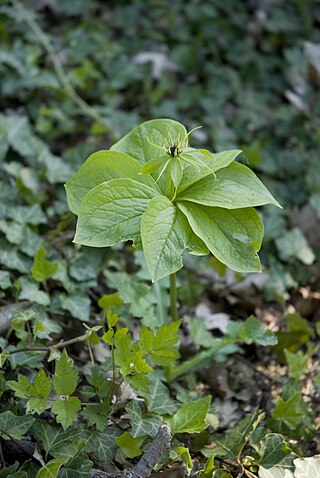
Paris quadrifolia, the herb Paris or true lover's knot, is a species of flowering plant in the family Melanthiaceae. It occurs in temperate and cool areas throughout Eurasia, from Spain to Yakutia, and from Iceland to Mongolia. It prefers calcareous soils and lives in damp and shady places, especially old established woods and stream banks.

Gagea is a large genus of spring flowers in the lily family. It is found primarily in Eurasia with a few species extending into North Africa and one species in North America.

Goodyera repens, an orchid in the genus Goodyera, is called by the common name creeping lady's-tresses in Anglophone Europe and dwarf rattlesnake plantain or lesser rattlesnake plantain in North America.

Lilium martagon, the martagon lily or Turk's cap lily, is a Eurasian species of lily. It has a widespread native region extending from Portugal east through Europe and Asia as far east as Mongolia.
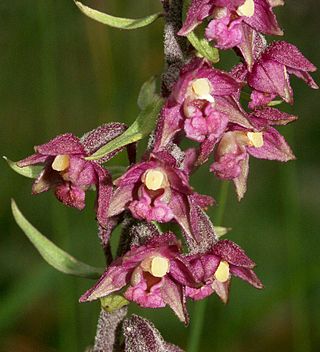
Epipactis atrorubens, the dark-red helleborine or royal helleborine, is an herbaceous plant in the orchid family, Orchidaceae.

Leonurus is a genus of flowering plants in the family Lamiaceae. It is native to Europe and Asia, naturalized in New Zealand, Hawaii, New Caledonia, and much of North and South America.

Rhaponticum is a genus of flowering plants in the tribe Cardueae within the family Asteraceae.

Neottia cordata, the lesser twayblade or heartleaf twayblade, is an orchid of upland bogs and mires that rarely exceeds 15 cm (5.9 in) in height. It was formerly placed in the genus Listera, but molecular phylogenetic studies have shown that Neottia nidus-avis, the bird's-nest orchid, evolved within the same group.
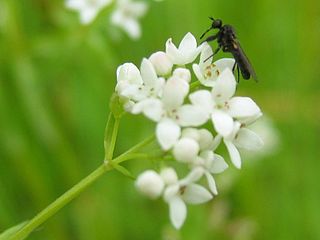
Galium palustre, the common marsh bedstraw or simply marsh-bedstraw, is a herbaceous annual plant of the family Rubiaceae. This plant is widely distributed, native to virtually every country in Europe, plus Morocco, the Azores, Turkey, Turkmenistan, Western Siberia, Greenland, eastern Canada, St. Pierre & Miquelon, and parts of the United States. The species is classified as a noxious weed in New York, Pennsylvania, Massachusetts, Connecticut, Vermont and New Hampshire. It is considered naturalized in Kamchatka, Australia, New Zealand and Argentina.

Galium saxatile or heath bedstraw is a plant species of the genus Galium. It is related to cleavers.

Epipactis palustris, the marsh helleborine, is a species of orchid native to Europe and Asia.

Cyperus fuscus is a species of sedge known by the common name brown galingale, or brown flatsedge. This plant is native to much of Europe, Asia and North Africa from England, Portugal and Morocco east to China and Thailand. It is an introduced species in North America, where it is naturalized in widely scattered locations in the United States and Canada.

Schoenoplectus pungens is a species of flowering plant in the sedge family known as common threesquare, common three-square bulrush and sharp club-rush. It is a herbaceous emergent plant that is widespread across much of North and South America as well as Europe, New Zealand and Australia.
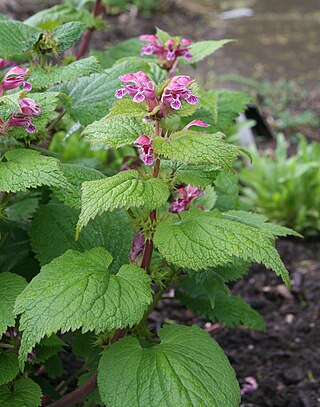
Lamium orvala, known as balm-leaved archangel, is a species of flowering plant in the family Lamiaceae, native to central eastern Europe.

Quercus pyrenaica, commonly known as Pyrenean oak, is a tree native to southwestern Europe and northwestern North Africa. Despite its common name, it is rarely found in the Pyrenees Mountains and is more abundant in northern Portugal and north and northwestern Spain.

Ceratophyllum submersum, commonly known as the soft hornwort or tropical hornwort, is a species of Ceratophyllum. It is a submerged, free-floating aquatic plant. It has been reported from Europe, Central Asia, northern Africa, scattered places in tropical Africa, Turkey, Oman, Florida, and the Dominican Republic. It is similar to the submerged macrophyte Ceratophyllum demersum, a congeneric plant that is found in most regions of the world.
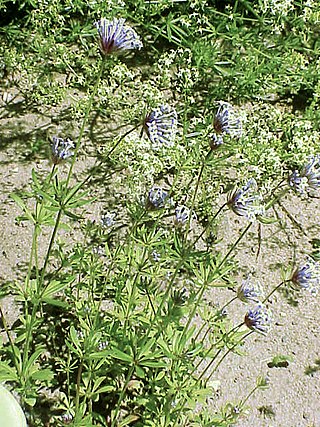
Asperula arvensis, known as blue woodruff, is a species of flowering plant in the family Rubiaceae. It belongs to the genus Asperula. It is native to most of Europe plus Algeria, Morocco, and southwest Asia from Turkey to Kyrgyzstan.

Allium carinatum, the keeled garlic or witch's garlic, is a bulbous perennial flowering plant in the family Amaryllidaceae. It is widespread across central and southern Europe, with some populations in Asiatic Turkey. It is cultivated in many places as an ornamental and also for its potently aromatic bulbs used as a food flavoring.

Drepanocaryum is a genus of flowering plant in the family Lamiaceae, first described in 1954. It contains only one known species, Drepanocaryum sewerzowii, native to west, central and south-central Asia.

Helleborus viridis, commonly called green hellebore, is a species of flowering plant in the buttercup family Ranunculaceae, native to Central and Western Europe, including southern England. All parts of the plant are poisonous.




















